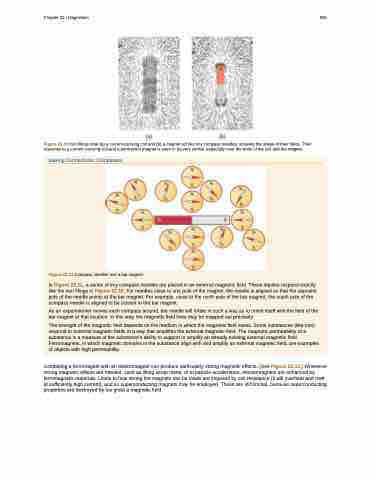Page 993 - College Physics For AP Courses
P. 993
Chapter 22 | Magnetism 981
Figure 22.10 Iron filings near (a) a current-carrying coil and (b) a magnet act like tiny compass needles, showing the shape of their fields. Their response to a current-carrying coil and a permanent magnet is seen to be very similar, especially near the ends of the coil and the magnet.
Making Connections: Compasses
Figure 22.11 Compass needles and a bar magnet.
In Figure 22.11, a series of tiny compass needles are placed in an external magnetic field. These dipoles respond exactly like the iron filings in Figure 22.10. For needles close to one pole of the magnet, the needle is aligned so that the opposite pole of the needle points at the bar magnet. For example, close to the north pole of the bar magnet, the south pole of the compass needle is aligned to be closest to the bar magnet.
As an experimenter moves each compass around, the needle will rotate in such a way as to orient itself with the field of the bar magnet at that location. In this way, the magnetic field lines may be mapped out precisely.
The strength of the magnetic field depends on the medium in which the magnetic field exists. Some substances (like iron) respond to external magnetic fields in a way that amplifies the external magnetic field. The magnetic permeability of a substance is a measure of the substance’s ability to support or amplify an already existing external magnetic field. Ferromagnets, in which magnetic domains in the substance align with and amplify an external magnetic field, are examples of objects with high permeability.
Combining a ferromagnet with an electromagnet can produce particularly strong magnetic effects. (See Figure 22.12.) Whenever strong magnetic effects are needed, such as lifting scrap metal, or in particle accelerators, electromagnets are enhanced by ferromagnetic materials. Limits to how strong the magnets can be made are imposed by coil resistance (it will overheat and melt at sufficiently high current), and so superconducting magnets may be employed. These are still limited, because superconducting properties are destroyed by too great a magnetic field.


